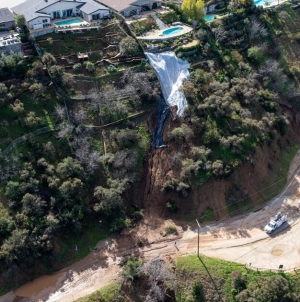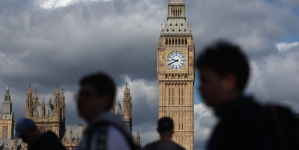-
Jurors Find San Francisco Homeless Man Not Guilty in Pipe Beating - December 23, 2023
-
A portion of Mulholland Drive, damaged by mudslides in winter storms, reopens - May 26, 2024
-
‘Maybe You Don’t Want to Win’ - May 26, 2024
-
Donald Trump Putting Law Enforcement in Danger: Attorney - May 25, 2024
-
Avoid the waters of these 5 L.A. County beaches this holiday weekend, public health officials say - May 25, 2024
-
Bawdy Comedy ‘Anora’ Wins Palme d’Or at Cannes Film Festival - May 25, 2024
-
Map Shows Heat Wave Zone Spread Into Five New States - May 25, 2024
-
Azusa police arrest suspected slingshot-wielding vandal - May 25, 2024
-
Donald Trump Hammers Judge Ahead of Jury Instructions - May 25, 2024
-
Sometimes U.S. and U.K. Politics Seem in Lock Step. Not This Year. - May 25, 2024
Jurors Find San Francisco Homeless Man Not Guilty in Pipe Beating
A homeless man who beat a former San Francisco city official with a metal pipe was found not guilty of assault charges on Friday, capping a case that had drawn national attention as a symbol of the city’s crime and homelessness problems until a public defender unearthed a surprising back story.
The defendant, Garret Allen Doty, 25, faced as many as seven years in prison had he been found guilty of the charges that stemmed from an altercation in San Francisco’s wealthy Marina district. On the evening of April 5, police responded to a neighborhood resident, Don Carmignani, 54, who had a fractured skull and severe injuries to his face that required more than 100 stitches. Multiple witnesses identified Mr. Doty as the assailant, and police arrested him minutes later.
But the public defender in the case, Kleigh Hathaway, determined that Mr. Carmignani had sprayed a canister of what appeared to be bear mace before Mr. Doty attacked him. Ms. Hathaway surfaced eight unsolved cases in which pepper spray or bear mace had been used against homeless people in the neighborhood. It was enough, she felt, to argue that Mr. Doty had responded in self-defense.
Jurors ultimately agreed on Friday.
“This case shows us that the citizens of San Francisco can still tell the difference between right and wrong,” Ms. Hathaway said afterward in an interview.
The San Francisco District Attorney’s Office said that it respected the jury’s decision and declined to comment further.
In April, Mr. Doty had recently moved to San Francisco from Louisiana and was living in a tent on the sidewalk near an apartment owned by Mr. Carmignani’s parents. After the attack, he was arrested and was charged with three felonies: assault with a deadly weapon, assault with force likely to produce grave bodily injury and battery causing serious bodily injury.
Mr. Carmignani was a cannabis entrepreneur who had briefly served on the San Francisco Fire Commission, an unsalaried panel. He also owns a number of properties around the city, including a building in the Financial District that houses a dispensary and an Italian sandwich restaurant.
Neither Mr. Doty’s defense lawyer nor the district attorney’s office disputed what had happened between the two men that evening in April: Bystanders with cellphones had captured videos that showed Mr. Doty striking Mr. Carmignani with what looked like a pipe, while Mr. Carmignani had his hands up in what seemed a defensive manner.
But there was less clarity about the motive for the attack — and especially about what had transpired in the moments just before witnesses had started recording video on their phones. After he was released from the hospital, Mr. Carmignani told a local television station that the beating reflected broader trends in the city.
“You have animals on the street saying they’re going to rape your daughter and kill your mother,” he said at the time. Various media outlets, including Fox News and local television stations, covered the story as an example of “lawlessness” in San Francisco and California at large.
But the picture was soon muddied by witness testimony. A Marina resident, Kristin Onorato, told the police that she had seen Mr. Carmignani tell Mr. Doty that he would “kill” him if he did not move his tent from the sidewalk. When Mr. Doty refused, she said, Mr. Carmignani sprayed him with a canister of bear mace — a faster-ejecting, higher-capsaicin version of pepper spray.
The case turned out to hinge on that canister. Looking through a crime database, the police found eight prior reports, dating back to 2021, in which a suspect had sprayed a homeless person in the Marina with a chemical substance.
“I believe the suspect is targeting the unhoused population for reasons unknown,” one officer had written at the time.
The descriptions of the suspect varied, but several of them were broadly similar to Mr. Carmignani’s physical appearance: a white man weighing between 250 and 300 pounds, standing about six feet tall.
Though nobody had been charged in the spray attacks, Ms. Hathaway used them to attempt a risky strategy: trying to link Mr. Carmignani to the prior incidents in order to demonstrate that her client, instead of being the aggressor, was acting to defend himself against a man who was believed to be a neighborhood vigilante.
At trial, Mr. Carmignani’s former mother-in-law testified that the individual seen in a blurry cellphone video of a prior bear-mace attack “looks like Don,” according to The San Francisco Chronicle. His ex-wife, Yvette Corkrean, now a Republican candidate for the California State Senate, testified that Mr. Carmignani had beaten her.
Kourtney Bell, an assistant district attorney, tried to persuade the jury that Mr. Carmignani’s history was not on trial in the case. Ms. Bell acknowledged that Mr. Carmignani was the initial aggressor, but said that Mr. Doty’s attack was an excessive form of revenge against him.
The San Francisco Police Department has opened an investigation into Mr. Carmignani in connection with the prior attacks.
San Francisco’s homelessness problem has attracted particular scrutiny since the beginning of the pandemic. The homeless population has not changed much since 2017 — hovering around 7,800, of whom some 4,400 are unsheltered. But a number of factors have contributed to a rise in anxiety, including overdoses and street-crime incidents that regularly go viral.
The still-unsolved attacks in the Marina point to a less-headline-grabbing reality, that violent attacks against the homeless have also become a part of life in California cities. In 2021, a homeless man died from burn injuries in San Francisco after his sleeping bag was set on fire. In November, three homeless men were shot dead while they slept on the streets of Los Angeles.
In April, weeks after the incident in the Marina, a homeless man named Banko Brown was shot in the chest and killed while attempting to steal candy from a Walgreens in San Francisco. In that case, the district attorney, Brooke Jenkins, declined to charge the security guard with murder, determining that he had acted in self-defense.































